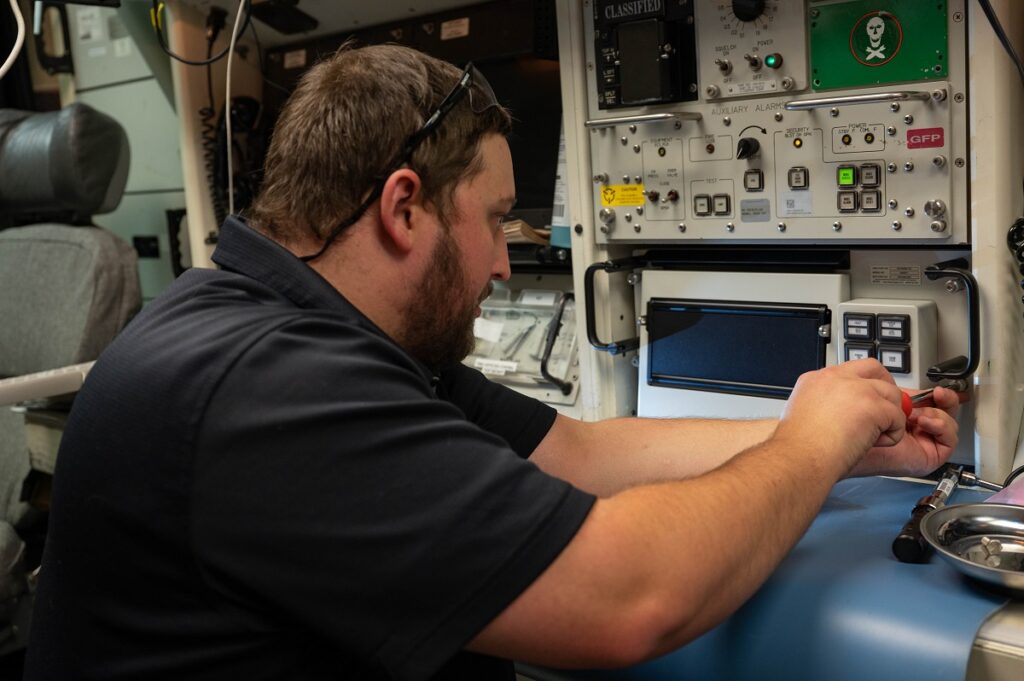The U.S. Air Force 90th Missile Wing at F.E. Warren AFB, Wyo. and Northrop Grumman [NOC] began Launch Control Center Block Upgrades (LCCBU) this month to modernize support equipment for the Boeing [BA] Minuteman III ICBMs, the 90th Missile Wing said.
The effort began at the Kilo-01 missile alert facility (MAF) near Dix, Neb. and is to extend to 14 other launch centers.
Northrop Grumman on Feb. 1, 2021 and March 17 last year won two contracts that could be worth about $38 million for LCCBU. That work is set to finish by July 17, 2023.

A Northrop Grumman field technician secures the new Launch Control Center printer on Dec. 2 at the Kilo-01 Missile Alert Facility near Dix, Nebraska. (U.S. Air Force Photo)
Kamala Parker, Northrop Grumman LCCBU program manager, said in a 90th Missile Wing statement that the Kilo-01 MAF was the company’s “first operational install for this program, and we have gone through a lot of development and production, so being in the deployment stage now is a big deal.”
“Much of the equipment in the LCCs has been operational since Minuteman III came online roughly 50 years ago,” per the 90th Missile Wing.
“The block upgrade program is designed to replace antiquated or obsolete equipment and support the weapon system with newer technology. The LCCBU effort is focused on upgrades to the journal memory loader and printer, as well as replacing the floppy disc drive with a flash data drive. Additionally, the LCCs are getting upgrades to the oxygen regeneration unit, which is responsible for generating breathable air in the event of a strike on the MAF,” the 90th Missile Wing statement continued.
LCCBU is to last until the Air Force retires the Minuteman III fleet by the mid-2030s or earlier.
The Minuteman III upgrades come as the Air Force plans to convert 450 Minuteman III silos to accommodate the Northrop Grumman LGM-35A Sentinel next generation ICBM.
Last month, Pittsburgh’s Gecko Robotics said that the Air Force Nuclear Weapons Center awarded the company an 18-month, $1.5 million Phase 2 Small Business Innovation Research contract to aid the Air Force in the planned Minuteman III-Sentinel silo conversion (Defense Daily, Nov. 29).
“Under the new contract, Gecko Robotics will integrate state-of-the-art concrete evaluation technology into their fleet of crawling robots,” the company said. “The hardware and software components together will provide the capability to rapidly assess concrete and steel liners in ICBM launch facilities. The ability to rapidly assess the current infrastructure of launch facilities is paramount to ensure a smooth transition to the Sentinel program and transition to a modernized sustainment program.”
In June, the Air Force Nuclear Weapons center at Hill AFB, Utah awarded BAE Systems an up to $12 billion contract for ICBM support through 2040 (Defense Daily, June 24).
Under the cost-plus-award-fee contract for the Integration Support Contract (ISC) 2.0, BAE will serve as the lead systems integrator and will complement government personnel in providing ICBM systems engineering, integration, and professional services.
BAE was the incumbent and won the approximately $534 million ISC contract in July 2013.
For ISC 2.0, BAE beat out four other offers, which included one from Integrated ICBM Support Services, LLC—a joint venture formed last year among Amentum, Apex Systems and Leidos [LDOS] (Defense Daily, Feb. 10, 2021).
The ISC 2.0 contract will support the aging Minuteman III ICBM force and the Sentinel, which may become operational in 2029 and remain so until 2075.
Northrop Grumman and Bechtel, which is to build the required LGM-35A infrastructure required for the 450 silos, may use predictive data to keep the Sentinel program on track.
An Air Force competition for the data layer for the 450 Sentinel silos may kick off next September.
In August last year, the Air Force Nuclear Weapons Center said that it had contracted with the Virginia-based Sabel Systems to create a “Teamcenter” hub to consolidate and organize data, enable enterprise-wide workflows, and “visualize” the health of the Minuteman III fleet, as the Air Force begins the transition to Sentinel.
This article was first published by Defense Daily, a sister publication to Avionics International; it has been edited.